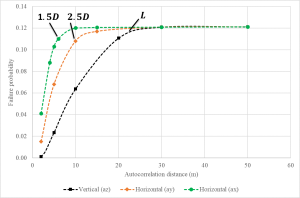
Background
Within the framework of the deterministic approaches, the mean values of the soil properties are used without taking into account the uncertainties of these parameters and without considering the spatial correlation of these properties. Thus, the output parameter is given by a single mean value which does not reflect the uncertainty associated with this parameter. The probabilistic approaches allow one to overcome this drawback. Indeed, the probabilistic approaches taking into account the soil spatial variability allow one to rigorously determine the response of the system under study as a probability density function PDF). One could even determine the probability of failure for an acceptable threshold of our output variable. This project aims at performing a probabilistic analysis of a wind turbine foundation taking into account the three-dimensional soil spatial variability and the loading variability.
Scientific advances and innovation
The deterministic computation of wind turbine foundations requires a three-dimensional (3D) analysis since these structures are subjected to complex loading (due to waves, wind, etc.) thus leading to very time-consuming computational models. This presents a great obstacle to the use of conventional probabilistic methods as Monte Carlo Simulation (MCS) methodology. On the other hand, taking into account the 3D soil spatial variability within a probabilistic analysis significantly increases the number of calls to the deterministic code. The objective of this project is to provide for these complex 3D offshore geotechnical structures, a reliable and efficient methodology for the propagation of uncertainty. Our aim is to determine the Probability Density Function (PDF) of the system response and the failure probability against a prescribed threshold within a reasonable computation time. Indeed, the existing probabilistic approaches do not allow one to rigorously compute the failure probability due to the use of a small number of simulations thus leading to a large value of the coefficient of variation on this failure probability.
Expected technical and economic impact
The analysis and design of offshore structures are generally performed using deterministic approaches. These approaches do not allow one to take into account the soil spatial variability and the variability of the loading. The object of the present project is the rigorous analysis of offshore structures taking into account the effect of these two variabilities. The study focuses on the probabilistic analysis of wind turbines foundations. The methods and tools developed within this project will be transfered to to practical geotechnical engineers, working in the area of offshore structures.
Key project milestones
- October 2016 - Begining of the project
- October 2017 - Developpement of deterministic approaches for wind turbines foundations
- October 2018 - Developpement of probabilistic approaches
- January 2020 - End of the project (Theisis defense and publications in international journals
Demonstrator
Development of numerical tools for the analysis of wind turbine foundations that may be used by practical geotechnical engineers working in the area of offshore structures.
Results
Objectives:
The work of this project involves two main items: (i) Development of efficient three-dimensional mechanical models for offshore wind turbine foundations subjected to axial and lateral loadings and (ii) Development of probabilistic models in order to calculate the probability of failure of offshore geotechnical structures taking into account the three-dimensional soil spatial variability.
Adopted methodologies:
– For the development of mechanical models, an offshore large diameter monopile was modelled using Abaqus finite element software. Two types of modelling were considered in the mechanical model: A wished in place model and a more sophisticated model taking into account the installation process. The later model makes use of the coupled Eulerian-Lagrangian approach implemented in Abaqus software.
– For the probabilistic analyses, three efficient probabilistic methods based on the Kriging metamodeling technique were developed in this work: GSAS, AK-MCSm and AK-MCSd. GSAS method combines Kriging with global sensitivity analysis, the objective being to provide a better enrichment of the meta-model as compared to the classical Kriging approach. AK-MCSm approach uses a multipoint enrichment technique. This is very useful in the case where parallel computing facilities are available. Finally, AK-MCSd approach uses the dependencies between the Kriging predictions and permits to reduce the computation time as compared to the classical Kriging approach.
The main results of the different simulations are as follows:
- For the determination of the ultimate vertical bearing capacity, there was an agreement between the numerical results provided by Abaqus and those obtained using the API. The contribution of the shaft and the base to the total resistance of the monopile has been determined. The results showed a major contribution of 60-80% for the shaft and a contribution of 20-40% for the base. Also, it was noticed that shaft failure occurs in a first place. It has been shown that the soil inside the monopile does not undergo slipping with respect to the internal interface of this monopile during the loading process. The bearing capacity of the monopile can thus be calculated as the sum of the shaft resistance and the base resistance (soil + annulus). This is in agreement with the recommendations of the API.
- The deterministic results of the large diameter monopile subjected to lateral loading have shown that the monopile undergoes a rotational rigid movement about a rotation point located at about the bottom third of the monopile embedded length. The results related to the monopile installation process in sand have shown that soil plugging phenomenon increases with the decrease of monopile diameter, the increase in the sand density, and the increase in the installation force. For large diameter monopiles, the plugging phenomenon was shown unlikely to occur. Furthermore, results have shown that the stress state around the monopile is significantly affected by the monopile installation. This change may have a significant effect on the monopile response.
- The three probabilistic methods were shown to present high efficiency (in terms of computational effort) with respect to the conventional Monte Carlo probabilistic approach and the classical Kriging-based probabilistic methods. AK-MCSm approach was found to be the most efficient method in terms of computation time but it requires available computational facilities. AK-MCSd approach was shown to be more efficient than GSAS approach since it is based on a more efficient enrichment methodology in terms of computation time. It has been shown that the effect of the 1-D vertical spatial variability on the failure probability is significant as long as the vertical autocorrelation distance is lower than the length of the monopile. Furthermore, it has been shown that the effect of the horizontal spatial variability appears when the horizontal autocorrelation distance becomes lower than where D is the monopile diameter. In the case of a 3-D soil variability, the use of a classical random field discretisation method (e.g. EOLE) induces a memory problem. In order to address this issue, the Turning Band Method TBM was proposed. This method was shown to be very efficient for the discretisation of a three-dimensional random field with very small autocorrelation distances (i.e. for the case of a very heterogeneous soil medium). Notice however that this method presents a shortcoming related to the large number of random variables required by this method, which impedes its combination with a Kriging-based approach that can handle a limited number of random variables.

Fig. Effect of the spatial variability on the failure probability
Publications and papers published
Publications
After conference:
- El Haj A-K., Soubra A-H., Fajoui J., Al-Bittar T. «Probabilistic model of an offshore monopile foundation taking into account the soil spatial variability», Proceedings of the 54th ESReDA Seminar, Nantes, France, April 25-26, 2018.
- El Haj A-K., Soubra A-H., Al-Bittar T. «Probabilistic analysis of a strip footing resting on a spatially varying soil using Kriging and global sensitivity analysis», 19th working conference of the IFIP Working Group 7.5 on Reliability and Optimization of Structural Systems, ETH Zurich, Switzerland, June 26-29, 2018.
- Abdul-Hamid Soubra, “Numerical modelling of offshore anchors for floating structures “, French-American Innovation Day (FAID), March 18 & 19th 2019
- El Haj A-K., Soubra A-H., «Probabilistic analysis of an offshore monopile foundation using Kriging with multipoint enrichment ». 13th international Conference on Applications of Statistics and Probability in Civil Engineering-ICAPS13, May 26-30, 2019
- El Haj A-K., Soubra A-H. (2019) «Improved Kriging-based approach for the probabilistic analysis of a large diameter monopile in a spatially varying soil», 7th International Symposium on Geotechnical Safety and Risk (ISGSR), Taipei, Taiwan, December 11-13
In papers:
- El Haj A-K., Soubra A-H., Fajoui J. «Probabilistic analysis of an offshore monopile foundation taking into account the soil spatial variability». Computers and Geotechnics, Février 2019
- El Haj A-K., Soubra A-H., Al-bittar, T. (2019) «Probabilistic analysis of strip footings based on enhanced Kriging metamodeling». International Journal for Numerical and Analytical Methods in Geomechanics, 43(17), 2667-2686.
- El Haj A-K., Soubra A-H. (2019) «Efficient estimation of the failure probability of a large diameter monopile in a spatially varying soil». Computers and Geotechnics, 121.
- El Haj A-K., Soubra A-H. (2020) «Improved active learning probabilisitc approach for the computation of failure probability», Structural Safety
PhD
-
- “Enhanced Kriging-based approaches for the probabilistic analysis of a large diameter offshore monopile in a spatially varying soil” menée dans le cadre du projet ” – Soutenance le 19 novembre 2019. Plus d’informations sur cette thèse








